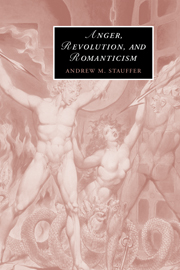Book contents
- Frontmatter
- Contents
- Acknowledgments
- List of abbreviations
- Introduction: fits of rage
- 1 Towards Romantic anger
- 2 Burke, Coleridge, and the rage for indignation
- 3 Inflammatory reactions
- 4 Provocation and the plot of anger
- 5 Shelley and the masks of anger
- 6 Byron's curse
- Epilogue
- Notes
- Bibliography
- Index
- CAMBRIDGE STUDIES IN ROMANTICISM
Epilogue
Published online by Cambridge University Press: 22 September 2009
- Frontmatter
- Contents
- Acknowledgments
- List of abbreviations
- Introduction: fits of rage
- 1 Towards Romantic anger
- 2 Burke, Coleridge, and the rage for indignation
- 3 Inflammatory reactions
- 4 Provocation and the plot of anger
- 5 Shelley and the masks of anger
- 6 Byron's curse
- Epilogue
- Notes
- Bibliography
- Index
- CAMBRIDGE STUDIES IN ROMANTICISM
Summary
Romanticism was shaped by its struggles with anger, particularly as that emotion emerged in legacy from the French Revolution and the English reaction. During this period, the angry passions were associated with volatile political change and destructive violence – things for which, on the domestic scene anyway, the majority of Englishmen had little taste during the Napoleonic Wars. The result was a general demonization of anger in Romantic-period thought, a wave of influence that affected political, moral, medical, legal, and literary discourse. In the work of the imaginative writers examined here, we find cases representative of these effects and yet unique in their authors' personal and creative efforts to find a productive role for anger in this time of trouble. Typically, this involves defining an “anger-that-is-not-mine,” a scapegoat emotion to be cast out in favor of an indignation or a wrath – even a vengefulness – that the author uses to perform a certain kind of work (be it moral, political, or aesthetic). As we saw in chapter 2, this mode of operation defined the Revolution debates as they were carried on in the 1790s, and it became one of the most lasting bequests from that period to the Romantics that followed.
After Waterloo, however, we do see a shift in overall emphasis, as the specific tensions and sharper conflicts of the Revolutionary and Napoleonic eras began to recede, and with them, the contestation over anger in the political sphere.
- Type
- Chapter
- Information
- Anger, Revolution, and Romanticism , pp. 164 - 174Publisher: Cambridge University PressPrint publication year: 2005

